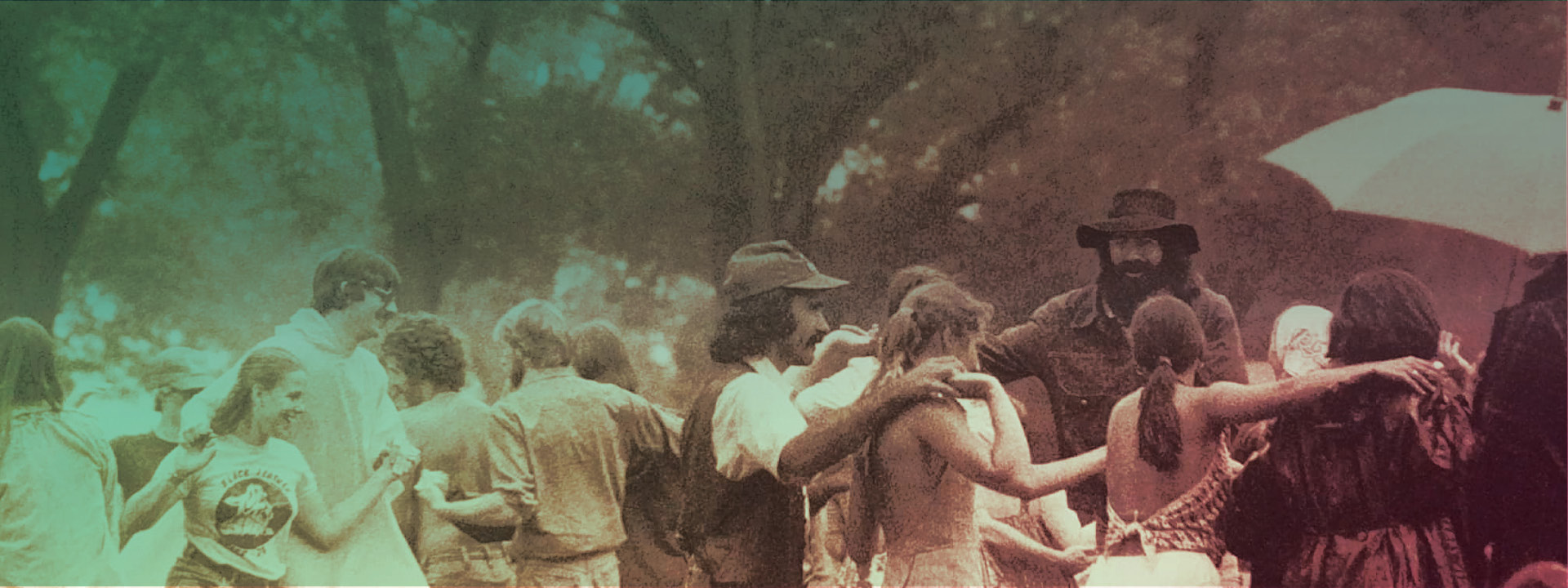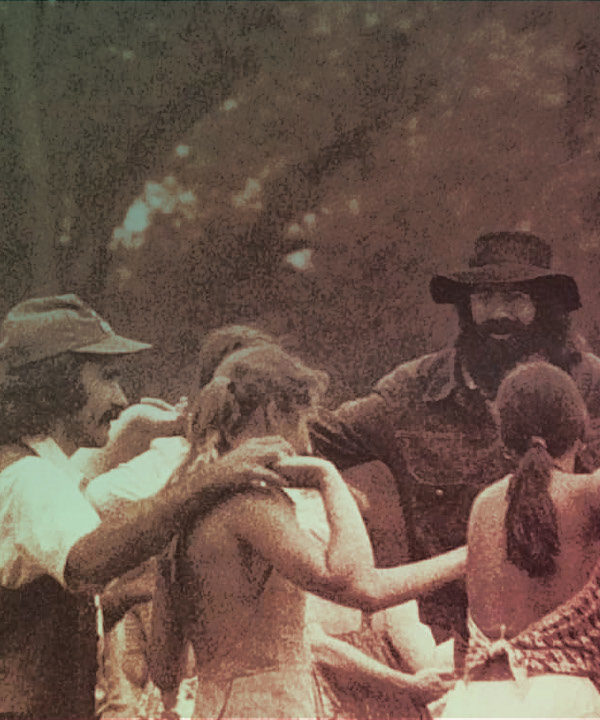The Transformation of Mariposa
By 1967 Mariposa had garnered a dedicated following of festivalgoers who returned each year to listen to some of the best music of their time. Most Mariposa performers went on to become the biggest music legends in the industry, with Mariposa among the first big gigs at the start of their career. From Joni Anderson to Leonard Cohen to Bruce Cockburn, Mariposa produced an incredible roster of artists thanks to the festival’s artistic director, Estelle Klein, who had an art for scoping out the biggest talents as they were starting out.

Photo: Leo Harrison
Once Mariposa was on the map as a prominent summer festival, it underwent significant changes to improve on previous years while continuing to reflect the spirit of the festival. In 1968 Tom Bishop purchased the rights of the festival and made the bold decision to move the Mariposa grounds from Innis Lake to Toronto Island. With its new big city location, the organizers wanted to capture the spirit of the hippie era and attract a more diverse, youthful audience. Toronto Island added charm and a new sense of adventure to the festival experience. To get to the festival grounds, festivalgoers were taken on a scenic ferry ride from the mainland and once they arrived, they were surrounded by the breathtaking scenery of water, trees, and greenery. Entering the festival grounds was an escape from city life into a serene community for a weekend of music and nature.
With its new location, it was only natural to complete the revitalization by redesigning the festival and foundation logo. While the organizers planned on attracting new festivalgoers, they also wanted to shed the backlash the festival had received in previous years from American songwriter Tom Rush, who criticized Mariposa for being too academic. Canadian singer-songwriter Murray McLauchlan, a dedicated festival volunteer with artistic skill, was chosen to redesign the logo. Mariposa’s iconic smiling-face sun brought a fresh new look to the festival’s brand and has remained the festival’s logo ever since.
Mariposa continued to showcase a diverse range of talent. In 1969 the festival featured bluegrass legend Bill Munro, blues performer Bukka White, Québécois singer Gilles Vigneault, superstars Joan Baez and James Taylor, Taj Mahal and Bruce Cockburn. Mariposa’s stages were taken over by some of the key players in the music industry, and they all left the audience wanting more.
Redefining the Folk Genre

Photo: David McQueen
In the following years, Mariposa was known as the place for exceptional music and a free-spirited experience. During this influential era, with similar music events happening around the world, many travelled to Toronto Island for the ultimate summer festival. But in 1970, the popularity of Woodstock and Festival Express resulted in gatecrashers at Mariposa demanding free entry. The atmosphere became aggressive and disorderly. Suddenly the future of Mariposa was unclear, with discussions of cancelling the following year’s festival until a suitable plan could be put into action.
Klein refused to accept a cancellation. She proposed an idea that would reformat the festival and (she hoped) deter gatecrashers. Her vision was to replace evening concerts with more workshops and symposium sessions. Once the Board of Directors agreed to Estelle’s vision, the 1971 festival trialled the new programming. For the first time ever, there were no evening concerts. Instead, six stages were developed with various activities from crafts to singalongs.
That same year, Klein broadened the definition of folk music by introducing world music into the programming. Using the festival’s influence to extend its reach, Klein created an ethnic committee responsible for finding musicians, dancers, and performers to represent the diverse immigrant community and multiculturalism of Toronto. Performers were invited from countries ranging from China to New Zealand, and Mariposa embraced diverse songs, dance, and culture from Zimbabwe, Turkey, India, and Peru.
From 1975 to 1979 Mariposa established a children’s and Native People’s area, which became key components of the festival in the late 70s. At the time, Canada produced some of the best-known children’s music artists including Raffi, Fred Penner, and Sharon, Lois & Bram, so it was clear why Mariposa wanted to highlight this genre while also allowing families to enjoy the festival together. Along with the children’s area, Mariposa established another initiative, Mariposa in the Schools (MITS), which was all about bringing folk music to schools in Ontario. This encouraged parents to continue their festival experience with their children and increased children’s involvement in and knowledge of music, offering them a platform to explore their creativity.
The Decade of Singer-Songwriters
The 1970s were all about folk music. It was arguably one of the most popular genres of pop music as singer-songwriters such as Murray McLauchlan, John Prine, Stan Rogers, and Steve Goodman rose on the scene.

Photo: David McQueen
This popularity benefitted Mariposa’s lineup and attendance. In 1972 some of the most influential singer-songwriters in the world came to Mariposa. Bob Dylan attended the festival as an audience member to watch Leon Redbone perform, while Murray McLauchlan gave up his concert to Joni Mitchell—who would later give her spot to Jackson Browne. Orillia native Gordon Lightfoot dropped in to watch various acts and indulge in the Mariposa experience. Canadian singer-songwriter Neil Young showed up to Mariposa unannounced and was asked to perform alongside Bruce Cockburn on Sunday. Though Cockburn was resistant to sharing his stage time with the more famous singer, Young ended up playing some of his classics including “Helpless,” “Heart of Gold,” “Sugar Mountain,” and “Harvest,” while Dylan and Lightfoot enjoyed the show from the crowd.
The workshops Klein organized in the post-1970 reformatting brought many of these incredible musicians on stage together for the first time. This included John Prine, The Original Sloth Band (Whiteley Brothers), Taj Mahal, Murray McLauchlan, Bonnie Raitt, David Bromberg, New Lost City Ramblers, Bruce Cockburn, Bukka White, Utah Phillips, Mike Seeger, Michael Cooney, Adam Mitchell, and Jean Ritchie.
The Decline of Mariposa

Source: Clara Thomas Archives & Special Collections
(below) Back to the sun
Source: Mariposa Folk Foundation
Over the years, Mariposa had surmounted hurdle after hurdle to keep the festival afloat. One of these included the weather forecast and rain showers that returned to the festival year after year. A fragmented entertainment market, changing tastes, and aging demographic also contributed to a decline in interest and attendance. As attendance began to decrease, so did the festival’s earnings, and the money loss was substantial.
Mariposa’s final year at Toronto Island came in 1979. In 1980 organizers decided to host a Mariposa Fall Festival at Toronto’s Harbourfront instead. In 1981 there was no festival. That same year Estelle Klein resigned as artistic director. In June 1982 the festival was held near the old site of the Maple Leaf Stadium at Bathurst and Lakeshore Boulevard. Organized by Tim Harrison, the festival featured an all-Canadian line-up for the first time. Though it was an impressive roster with the likes of Nancy White, Graham Townsend, Caitlin Hanford, and Stan Rogers, Mariposa could not recover from an $80,000 debt due to low ticket sales and overspending on production costs.
It was clear Mariposa wasn’t what it used to be. MITS was also suffering financially, and with a debt of $140,000 there seemed to be no solution in sight. In 1983, the festival was cancelled. There were whispers among festival organizers that the Mariposa Folk Festival could be terminated for good.

